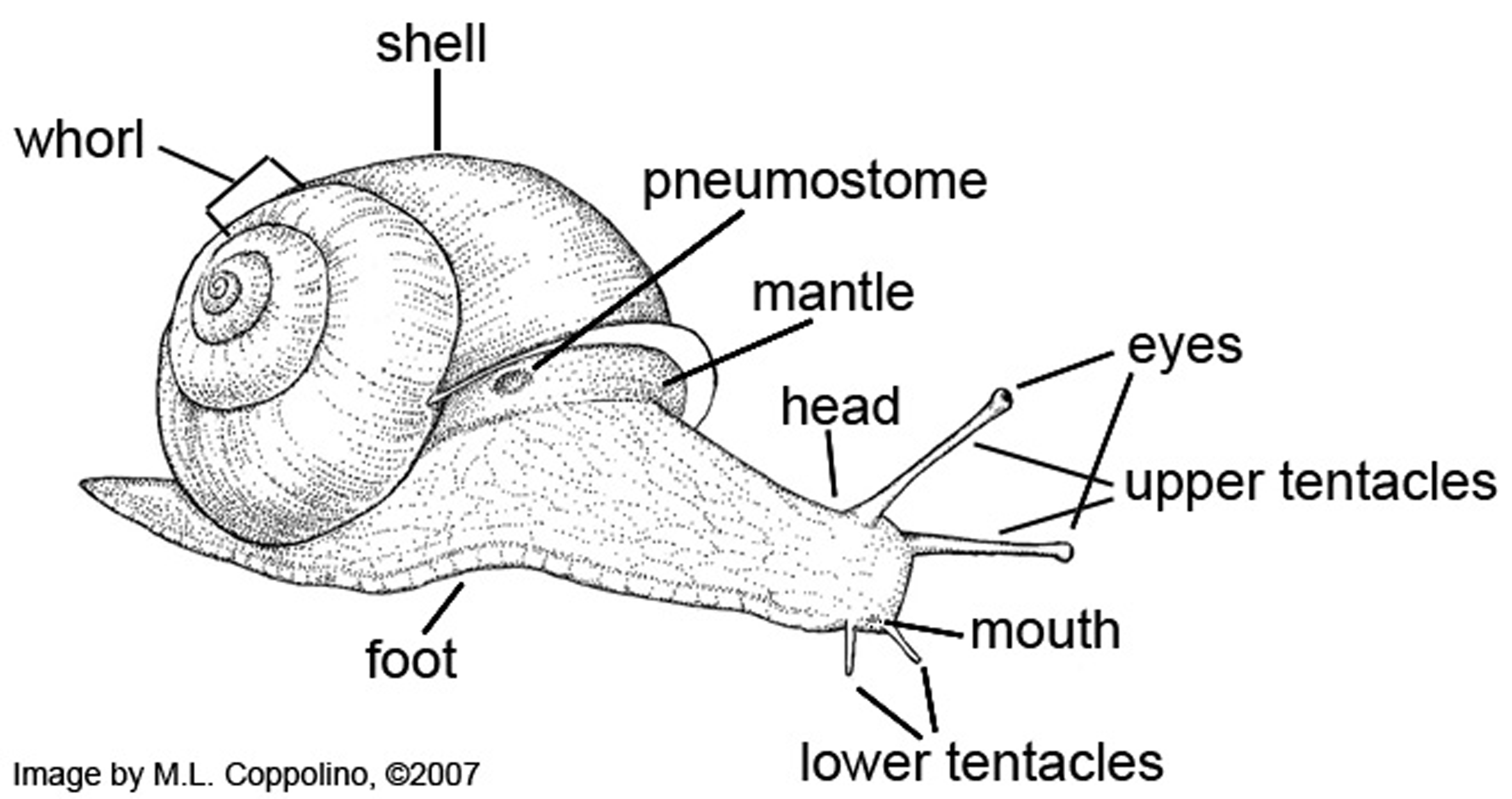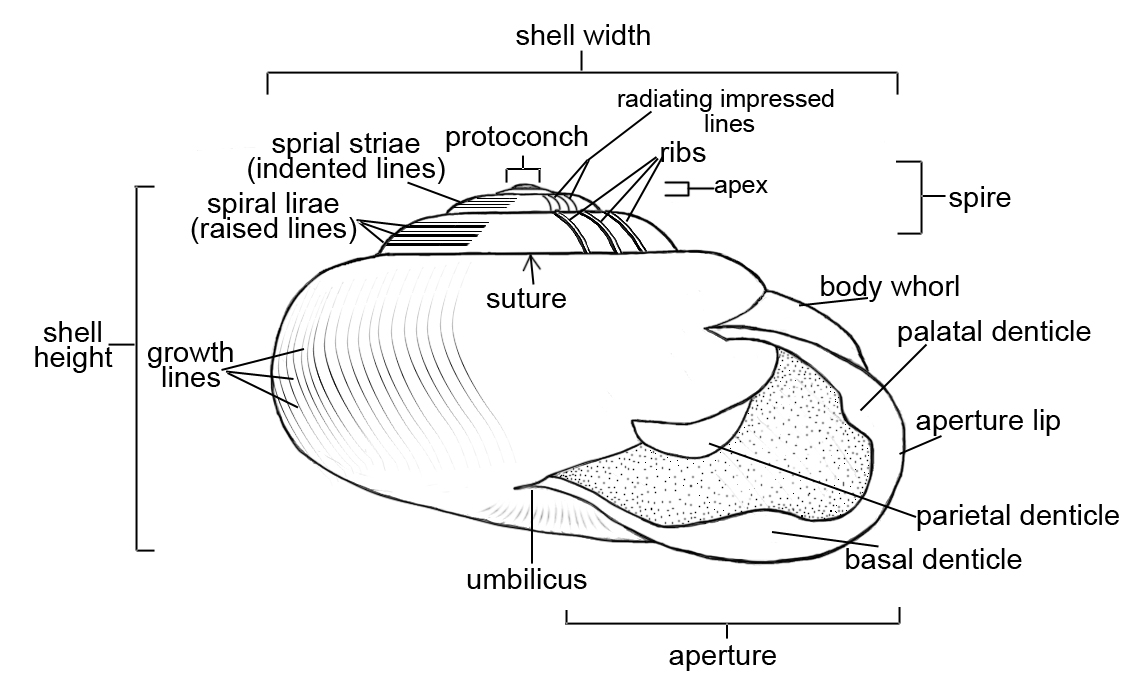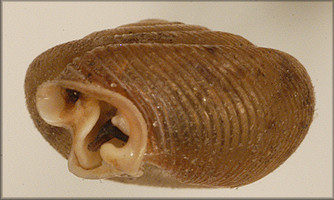Facts
The following paragraphs contain general facts about snails such as their shell characteristics and overall body plan. Below is an image of a typical terrestrial snail. Since Millerelix jacksoni, or Ozark Liptooth, is a terrestrial snail of the Southern United States it has many characteristics in common with those of other terrestrial snails. One typical characteristic is a coiled shell. The shell is a hard covering made from calcium mineral deposits on the mantle that protects the snail from predators (Illinois DNR, 2009). The snail's head may be retracted into the shell when it senses danger (Hickman et al, 2012). The evolution of a shell was an important adaptation for snails. The mantle of a snail is an internal covering within the shell that surrounds the internal organs. Outside a snail's shell is a soft-body mass called the foot which aids in snail movement by sliding over an excreted mucus trail. This mucus trail is produced by glands on the snail's exterior body surface (Illinois DNR, 2009). The soft non-segmented body of the snail contains the snail's head which has two pairs of tentacles, an upper pair and a lower pair. These tentacles are sensory organ which help the snail to sense its environment (Illinois DNR, 2009). Finally, Millerelix jacksoni possesses a hole in its mantle called a pneumostome. The pneumostome is an adaptation that developed when part of the mantle cavity developed into an air breathing lung (Hickman et al, 2012). The pneumostome allows air to enter thus aiding terrestrial snails in breathing (Illinois DNR, 2009).
Millerelix jacksoni has a shell height of 3.6mm - 3.9mm (Pilsbry, 1940) and a width of 7mm – 9.3mm (Burch, 1962). The shell is shiny, grooved, and slightly elevated with a spherical shape (see image of shell below) that bulges outwards and has a narrow depression that resembles a navel/bellybutton called the umbilicus (Binney, 1869).
The shell has a darker or pale horn color (a shade of tan) with six consecutive whorls or coils (Pilsbry, 1940). Although in some snails the number of whorls ranges anywhere from five and a half to six whorls (Burch, 1962). The six whorls are slightly curved and increase slightly in layers, much like a tiered wedding cake. The largest whorl, which is the base whorl, rests behind the shell's aperture, or shell opening, (Binney, 1869) that contains three teeth (Pilsbry, 1940). The images below show a close relative of Millerelix jacksoni and display the three teeth as well as the increasing layer of whorls and the pale horn color of Millerelix jacksoni. The lip of the shell around the shell opening is thick and brownish-red in Millerelix jacksoni and joined by a whitish denticle, or tooth-like projection (Binney, 1869). The denticle and a missing internal shell structure are key characteristics to help distinguish Millerelix jacksoni from similar species (Binney, 1869).
Other interesting facts include the fact that the Class Gastropoda is the largest class of Mollusca containing some 40,000 species of snails, slugs, limpets, etc. (Hickman et al, 2012) and snails are hermaphroditic organisms, they have both male and female genitalia (see the reproduction page) (Illinois DNR, 2009). Another fact is that snails have an open circulatory system, unlike their sister class the Cephalopods who have a closed circulatory system (Hickman et al, 2012). This open circulatory systems contains one ventricle and auricle for the heart chambers (Illinois DNR, 2009).
One really interesting fact about Millerelix jacksoni is that the species epithet, jacksoni, was named after Dr. R.M.S. Jackson, an army surgeon in America during the 1800's (Pilsbry, 1940).
Below is a list of some important general terminology for a snail's body and shell structure. Each of these has been discussed in the previous paragraphs and is depicted in one of the images above:
Aperature: Opening of the whorls into the shell; the open space inside the shell where the snail's organs are found (Hickman et al, 2012).
Denticle: A U- or V- shaped (Emberton, 1994) small projection that resembles a tooth and projects towards the inside of a snail's shell (Illinois DNR, 2009). Plays a vital role in defense for the snails because it keeps out insects that may climb inside the snail's shell to eat it (Illinois DNR, 2009).
Foot: The base of the snail that aids in snail movement by sliding over an excreted mucus trail (Illinois DNR, 2009).
Head: Anterior part of the snail where the tentacles and mouth are located (Hickman et al, 2012).
Mantle: An internal covering located within the shell that surrounds a snail's organs (Illinois DNR, 2009).
Mucus: Fluid produced in glands on the snail's exterior skin which prevents the snail from losing fluids and aids the snail in movement by movement of the foot over an excreted mucus trail (Illinois DNR, 2009).
Pneumostome: An air hole located on the mantle where air enters to aid terrestrial snails in breathing (Illinois DNR, 2009) since they lack gills (Hickman et al, 2012).
Plumonata: Terrestrial land snail that is hermaphroditic (Hickman et al, 2012).
Radula: Tongue that scrapes and rasps used for snails to eat (Hickman et al, 2012).
Shell: Hard covering on snail made from calcium mineral deposits on the mantle that protects the snail from predators (Illinois DNR, 2009). Head may be retracted into the shell (Hickman et al, 2012).
Tentacle: A long and extended sensory organ located on a snail's head (Illinois DNR, 2009). Most snails have two tentacles.
Umbilicus: A narrow depression that resembles a navel/bellybutton (Binney, 1869).
Whorl: Spiral or coil on a snail's shell (Illinois DNR, 2009).



